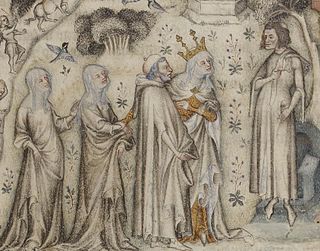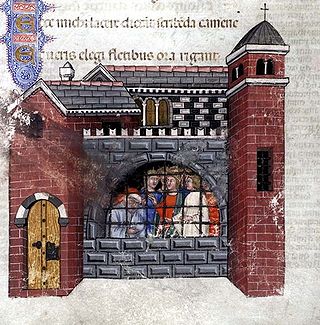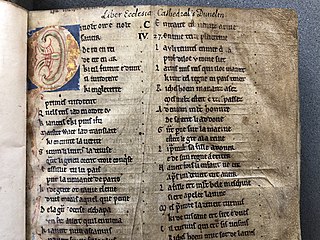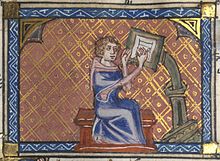
Christine de Pizan or Pisan, was an Italian-born French poet and court writer for King Charles VI of France and several French dukes.

In Greek mythology, Echo was an Oread who resided on Mount Cithaeron. Zeus loved consorting with beautiful nymphs and often visited them on Earth. Eventually, Zeus's wife, Hera, became suspicious, and came from Mount Olympus in an attempt to catch Zeus with the nymphs. Echo, by trying to protect Zeus, endured Hera's wrath, and Hera made her only able to speak the last words spoken to her. So when Echo met Narcissus and fell in love with him, she was unable to tell him how she felt and was forced to watch him as he fell in love with himself.

Guillaume de Machaut was a French composer and poet who was the central figure of the ars nova style in late medieval music. His dominance of the genre is such that modern musicologists use his death to separate the ars nova from the subsequent ars subtilior movement. Regarded as the most significant French composer and poet of the 14th century, he is often seen as the century's leading European composer.

The Romaunt of the Rose is a partial translation into Middle English of the French allegorical poem, Le Roman de la Rose. Originally believed to be the work of Chaucer, the Romaunt inspired controversy among 19th-century scholars when parts of the text were found to differ in style from Chaucer's other works. Also the text was found to contain three distinct fragments of translation. Together, the fragments—A, B, and C—provide a translation of approximately one-third of Le Roman.
This article contains information about the literary events and publications of the 13th century.

Medieval literature is a broad subject, encompassing essentially all written works available in Europe and beyond during the Middle Ages. The literature of this time was composed of religious writings as well as secular works. Just as in modern literature, it is a complex and rich field of study, from the utterly sacred to the exuberantly profane, touching all points in-between. Works of literature are often grouped by place of origin, language, and genre.

Guillaume de Lorris was a French scholar and poet from Lorris. He was the author of the first section of the Roman de la Rose. Little is known about him, other than that he wrote the earlier section of the poem around 1230, and that the work was completed forty years later by Jean de Meun. He is only known by mention of Jean de Meun,, in Roman de la Rose.

Jean de Meun was a French author best known for his continuation of the Roman de la Rose.

The Roman de Fauvel is a 14th-century French allegorical verse romance of satirical bent, generally attributed to Gervais du Bus, a clerk at the French royal chancery. The original narrative of 3,280 octosyllabics is divided into two books, dated to 1310 and 1314 respectively, during the reigns of Philip IV and Louis X. In 1316–7 Chaillou de Pesstain produced a greatly expanded version.

The Lancelot-Grail Cycle, also known as the Vulgate Cycle or the Pseudo-Map Cycle, is an early 13th-century French Arthurian literary cycle consisting of interconnected prose episodes of chivalric romance originally written in Old French. The work of unknown authorship, presenting itself as a chronicle of actual events, retells the legend of King Arthur by focusing on the love affair between Lancelot and Guinevere, the religious quest for the Holy Grail, and the life of Merlin. The highly influential cycle expands on Robert de Boron's "Little Grail Cycle" and the works of Chrétien de Troyes, previously unrelated to each other, by supplementing them with additional details and side stories, as well as lengthy continuations, while tying the entire narrative together into a coherent single tale. Its alternate titles include Philippe Walter's 21st-century edition Le Livre du Graal.

Medieval French literature is, for the purpose of this article, Medieval literature written in Oïl languages during the period from the eleventh century to the end of the fifteenth century.

A dream vision or visio is a literary device in which a dream or vision is recounted as having revealed knowledge or a truth that is not available to the dreamer or visionary in a normal waking state. While dreams occur frequently throughout the history of literature, visionary literature as a genre began to flourish suddenly, and is especially characteristic in early medieval Europe. In both its ancient and medieval form, the dream vision is often felt to be of divine origin. The genre reemerged in the era of Romanticism, when dreams were regarded as creative gateways to imaginative possibilities beyond rational calculation.

The Brut or Roman de Brut by the poet Wace is a loose and expanded translation in almost 15,000 lines of Norman-French verse of Geoffrey of Monmouth's Latin History of the Kings of Britain. It was formerly known as the Brut d'Engleterre or Roman des Rois d'Angleterre, though Wace's own name for it was the Geste des Bretons, or Deeds of the Britons. Its genre is equivocal, being more than a chronicle but not quite a fully-fledged romance.
Ernest Langlois was a French medievalist, professor at the University of Lille.
Sylvia Huot is a professor of Medieval French Literature at the University of Cambridge and fellow of Pembroke College. She is the author of several internationally renowned books on Medieval French Literature and the leading expert on the manuscripts of Roman de la Rose, having published extensively on its iconography.

Prise d'Orange is a mid-12th century chanson de geste written in Old French. Its fictional story follows the hero Guillaume as he captures the walled city of Orange from Saracens and marries Orable, its queen. Other characters include Arragon, the king of Orange, and Tibaut, Orable's erstwhile husband and Arragon's father. The anonymously written poem, part of a larger cycle about Guillaume called La Geste de Garin de Monglane, consists of 1,888 decasyllable verses in laisses. It combines motifs of courtly love with an epic story of military conquest. The narrative is humorous and parodies the tropes of epic poetry.

Hein van Aken, also called Hendrik van Aken or van Haken, was the parish priest in Korbeek-Lo, between Leuven and Brussels. He was born in Brussels, probably in the thirteenth century. He translated the Roman de la Rose by Guillaume de Lorris and Jean de Meun to Dutch, with the title Het Bouc van der Rosen,. Hein's translation, also commonly called Die Rose, was widespread. This is notable due to the many manuscripts and excerpts that are still preserved, for example in the University Library of Ghent. He is probably also the poet of a Dutch reworking of the French Ordene de chevalerie. With less reason, some also attribute the Natuurkunde van het Geheel-al to him, but a poem by him must be kept in the Comburger manuscript.
Guillaume de Dole is an Old French narrative romance by Jean Renart. Composed in the early 13th century, the poem is 5,656 lines long and is especially notable for the large number of chansons it contains, and for its active female protagonist. The romance incorporates forty-six chansons ; it is the first extant example in French literature of a text that combines narrative and lyric. Its form was quickly imitated, by authors such as Gerbert de Montreuil, and by the end of the 13th century had become canonical.

The Chansonnier d'Arras is an illuminated manuscript of the late 13th century containing a variety of religious and philosophical texts and songs in 220 folios. It is written in the Picard dialect of Old French. It is now manuscript 657 in the municipal library of Arras. In trouvère studies, it is known by the conventional siglum A.

Nicole de Margival was an Old French poet active around 1300. His two known works are Le Dit de la panthère d'amours and Les trois mors et les trois vis.























